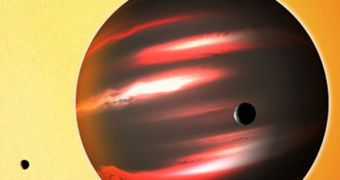Astronomers at the Princeton University and the Harvard-Smithsonian Center for Astrophysics (CfA) announce the discovery of the darkest extrasolar planet known to date. The object, called TrES-2b, absorbs more than 99.9 percent of all light shone on it.
The celestial body is more massive than Jupiter, which places it in the gas giant category. Figuring out why it absorbs so much light could help scientists explain similar occurrences detected on other exoplanets discovered thus far.
Statistically speaking, this weird exoplanet is the most light-thirsty object in the known Universe, the team explains. The work was led by Princeton Department of Astrophysical Sciences postdoctoral researcher David Spiegel.
He worked closely with CfA postdoctoral researcher David Kipping, who was the other leader of the study. Their joint study is published in a recent issue of the esteemed journal Monthly Notices of the Royal Astronomical Society.
According to the two, TrES-2b sets a new standard for how much light a gas giant can absorb. This class of planets is known for hoarding photons to some extent, but such extreme efficiency has never been witnessed before.
This particular planet belongs to the hot Jupiter class, which means that it orbits very close to its parent stars, and is tidally locked to it. What this means is that it always keeps the same face oriented towards the star, like the Moon does in respect to Earth.
Of the 600+ exoplanets confirmed thus far, more than 150 are hot Jupiters. The mass, orbital pattern and atmospheric makeup readings that these objects provide have been puzzling astronomers for a long time, but more and more studies are beginning to shed light on their properties.
Interestingly enough, where TrES-2b located in our solar system, it would appear to be 3,000 times more luminous than Venus, primarily because if glows in infrared wavelengths. Temperatures on its surface and atmosphere are many times higher than those on Mercury.
“We found evidence suggesting that something that seems to be present and absorb light in other planets hasn't been accounted for in basic models of TrES-2b,” Spiegel explains.
“It looks like there's something missing from our list of 'ingredients' that make up the atmosphere of this planet. It is absorbing a lot of the optical light that hits this planet, but we're not sure what that extra ingredient is,” the expert concludes.

 14 DAY TRIAL //
14 DAY TRIAL //